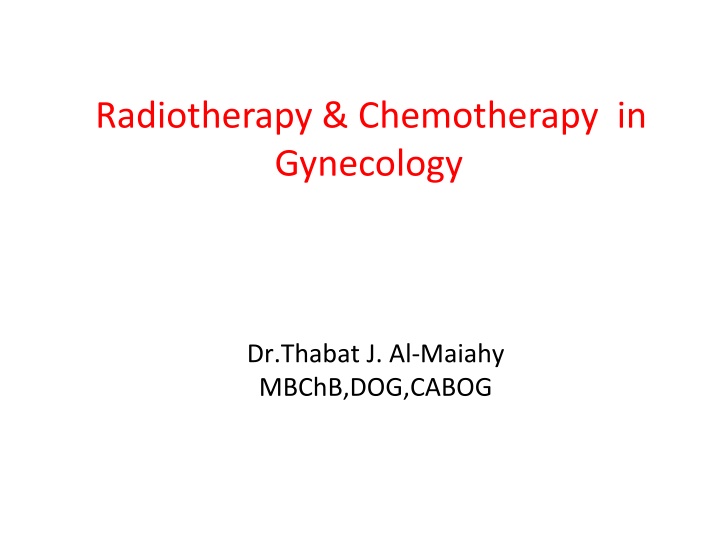
Effects of Radiotherapy on Gynecological Tissues
Explore the impact of radiotherapy on gynecological tissues, including details on external radiation therapy, brachytherapy, normal tissue responses, and factors affecting radiation damage. Learn about the potential effects on epithelium, parenchyma, skin, and vagina, providing valuable insights for patients undergoing treatment.
Download Presentation

Please find below an Image/Link to download the presentation.
The content on the website is provided AS IS for your information and personal use only. It may not be sold, licensed, or shared on other websites without obtaining consent from the author. If you encounter any issues during the download, it is possible that the publisher has removed the file from their server.
You are allowed to download the files provided on this website for personal or commercial use, subject to the condition that they are used lawfully. All files are the property of their respective owners.
The content on the website is provided AS IS for your information and personal use only. It may not be sold, licensed, or shared on other websites without obtaining consent from the author.
E N D
Presentation Transcript
Radiotherapy & Chemotherapy in Gynecology Dr.Thabat J. Al-Maiahy MBChB,DOG,CABOG
EXTERNAL RADIATION THERAPY Indicated when an area to be irradiated is large, e.g cx cancer The basic tent of radiation therapy is to maximize the tumor damage while minimizing the the damage to the surrounding normal tissues ,the area determined by means of modern imaging modality: CT , MRI, PET ..
BRACHYTHERAPY Means treatment at a short distance. During this therapy sealed or unsealed radioisotopes are inserted or instilled in to the cancer or its immediate vicinity. Indicated only when the cancer size is small ,less than 3-4cm in greatest dimension BT is typically practiced after external radiation therapy has decreased the tumor size Intra cavitory, interstitial, intra peritoneal brachytherapy: During intra cavitory BT ,the applicators holding the sealed sources, such as cesium are inserted in to a body cavity such as the uterus, interstitial BT requires the placement of catheters or needles directly in to the cancer and surrounding tissues. The typical sources used in interstitial brachytherapy is irridum unsealed sources, such as phosphorus and gold are available as solutions for instillation in to peritoneal cavities
NORMAL TISSUE RESPONSE TO IONIZING RADIAATION
In general radiation therapy is less well tolerated when: 1-the size of tissues irradiated is large. 2- dose is high 3- the dose per fraction is large 4-the patient age is advanced
Factors that can exacerbated the radiation damage to normal tissue these include 1. Previous surgery 2. Concurrent chemotherapy 3. Infection 4. Diabetes mellitus 5. HT 6. Inflamatory condition (crohn disease & ulcerative colitis)
What are the effect of(RT)on tissues?
1-epithelium and parenchyma Atrophy is the most consistent sequel (include lining epithelium skin GIT ..) necrosis ,ulceration ,capillary the most sensitive vessels ,rupture wall ,large arteries (atheroma-like calcification)may develop. 2-skin erythema, dry desqumation, necrosis ,hyper and hypopigmentation can be seen ,the skin remains atrophied, thin and dry. 3-vagina commonly leads to acute vaginal mucositis, mucosal ulceration is rare. delayed reaction ,vaginal shortening ,atrophic vaginitis ,formation of synechiae or telangictasia ,these avoided ,by use the dilators vaginal intercourse resumed following treatment Rectovaginal fistula can develop after advanced stage cancer.
4-ovary and pregnancy outcomes It s effect depend on age and dose of IR( above 40 years sterility) Among female childhood cancer survivors who received abd irradiation ,higher spontaous abortion ,lower first born birth weight. 5-bladder acute cystitis 2-3 weeks of start treatment, frequency ,pain develop commonly hematuria is rare Major chronic complications bladder contracture , haematuria 6- small bowel vulnerable to IR acute early damage acute malabsorption syndrome (nausea ,vomiting,diarrhea,pain) later chronic nature of radiation induced enteritis 7-kidney acut radiation nephropathy typically 6-12 month after IR expose ,chronic nephropathy may occur after special cases.
Development of a secondary, radiation- induced cancer depends on the age at exposure, dose of IR, and susceptibility of specific tissue types to radiation-induced carcinogenesis High: breast ,BM Moderate: ovary, bladder Low :cx, uterus, rectum
Each characteristics ,which explains why the same chemotherapy regimen is not equally effective for the whole spectrum of gynaecology cancers? tumor type has its own
TYPES 1. Primary for patients with an advanced malignancy when no feasible alternative treatment exists 2. Adjuvant describes systemic treatment after a primary tumor has been controlled but risk of recurrence remains high 3. 3.Neoadjuvant refers to drug treatment directed at an advanced cancer to decrease preoperatively the extent or morbidity of asubsequent surgical resection 4. Salvage applied to recurrent tumor that is refreactory to initial treatment
Combination therapy In principle combination ofchemotherapy provides maximum cell kill with minimal or tolerable adverse patient side effect Drugs are selected based on their proven efficacy as single agents, different mechanisms of action ,and minimally overlapping toxicities Multiple drugs with different mechanism of action tends to minimize the emergence of drug resistance Drugs used in any combination should have clinical data indicating that their effects will be synergistic or at least additive in evaluating response to chemotherapy
HOW TO EVALUAT RESPONSE TO CHEMOTHERAPY?
Partial response a decrease of 50%or more in the product of all measurable lesion lasting for at least one month with out the development of new lesions Stable disease A decrease of <50 percent or an increase of <25 percent in the product of the diameters of all measurable disease Progression an increase of 25% or more of measurable lesion as described above or the identification of new lesions Complete response resolution of all disease lasting for at least one month
CHEMOTHERAPUTIC DRUGS In gynecological oncology diverse compounds that have demonstrated activity includes Antimetabolites ,alkalating agents ,anti tumor antibiotic ,plant ,hormonal agents ,vaccines. These drugs may be used as single agent or in combination regimens alkaloids,taxans ,biologic therapies
BIOLOGICAL THERAPY Designed to more accurately target specific tumors while avoiding much of the toxicity seen inconventional chemotherapy, refered to as immunotherapy or biological response modifer therapy May enhance the malignant cell to treatmrnt or may use the body immune system to attack the cancer chemosensitivity of
VACCINES Therapeutic cancer vaccines are designed to induce cellular component of the immune system to recognize and attack tumors Bone toxicity ,GIT toxicity






















